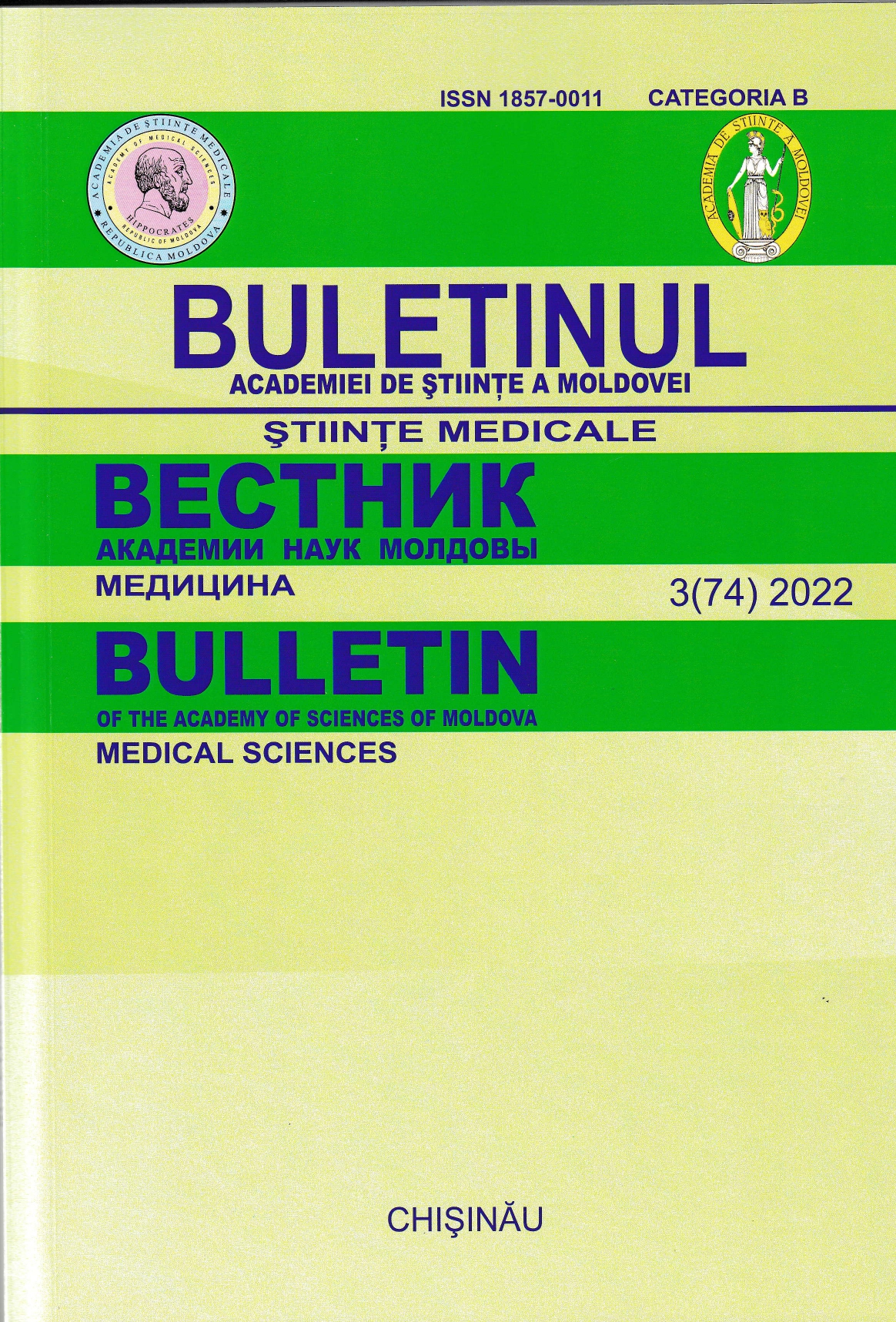THE PRODUCTION OF PRO-INFLAMMATORY CYTOKINES AND THE STATE OF CELLULAR IMMUNITY IN PATIENTS WITH PULMONARY TUBERCULOSIS WITH AND WITHOUT RELAPSE
DOI:
https://doi.org/10.52692/1857-0011.2022.3-74.18Keywords:
roinflammatory cytokines, tuberculosis, relapse, cellular immunityAbstract
The purpose of the study was to conduct a comparative study of the synthesis of pro-inflammatory cytokines, the state of cellular immunity, free radical oxidation reactions and antioxidant protection in patients with pulmonary tuberculosis with and without relapse. Material and methods. The study was carried out on two groups of patients: the first group basic which included 39 patients with relapsed pulmonary tuberculosis (TBR); 2nd control group 39 patients with non-relapsed pulmonary tuberculosis (TB). Pro-inflammatory cytokines (TNF-α, IL-2 IL-6), CD-3 lymphocyte content, lymphocyte blast transformation response to phytohemagglutinin and tuberculin, NBT-test, AOPP, SOD, and catalase were determined in patients of both groups and healthy people. Results. In patients with tuberculosis with relapses, compared with patients without relapses, complaints of cough and dyspnea were more often presented, a longer duration of hospitalization, late abacillation. In patients with relapses, a pronounced suppression of the functional and specific activity of lymphocytes and neutrophils was noted, which is confirmed by high levels of lipid peroxidation (Advanced Oxidation Protein Products AORP) and low levels of the antioxidant system (SOD and catalase). The high content of pro-inflammatory cytokines in patients with relapses indicates a higher activity of the inflammatory process in these patients and corresponds to a low blast formation rate for both phytohemagglutinin and tuberculin. Conclusion. Сhanges in the content of pro-inflammatory cytokines, the state of cellular immunity and the characteristics of reactions of free radical oxidation and antioxidant protection indicate a higher activity of the inflammatory process in patients with pulmonary tuberculosis with relapses compared to patients without relapses, which led to a longer duration of hospitalization, late abacillation.
References
Gudumac V., Tagadiuc O., Rîvneac V. et al. Investigaţii biochimice. Elaborare metodică. Micrometode, Vol. II. Tipografia Elena V. SRL. Chişinău, 2010, 98 p.
Bowssiotis V., Tsai E., Ynis E. IL-10 – producing T-cells suppress immune responses in anergic tuberculosis patient. Y. Clin. Invest. 2000. V. 105. № 9. Р. 1317–1325.
Park B.H. et al. Infection and Nitroblue–tetrazolium Reduction by Neutrophils. The Lancet, vol 11, 1968, N 7567, p. 532–534.
Urdahl K.B., Liggit D., Bevan M.J. et al. CD8+ T cells accumulate in the lungs of Mycobacterium tuberculosis-infected mice, but provide minimal protection. J. Immunol. 2003. Vol. 170. № 2. Р. 1987–1994.
Witko-Sarsat V, Friedlander M, Capeillère-Blandin C, et al. Advanced oxidation protein products as a novel marker of oxidative stress in uremia. Kidney Int. 1996 May;49(5):1304-1313].
Гинда С.С. Модификация микрометода реакции бласттрансформации лимфоцитов. Лабораторное дело. – 1982. – № 8. – С. 23–25.
Ерохин В.В. О некоторых механизмах патогенеза туберкулеза. Проблемы туберкулеза. – 2009. – № 11. – С. 3–9.
Китаев М.И., Алишеров А.Ш., Дуденко Е.В., Сыдыкова С.С., Чонорова О.А. Цитокиновый профиль больных лекарственно-устойчивым и лекарственно-чувствительным туберкулезом легких. Вестник КРСУ. 2012. Том 12. № 2, С. 75-79.
Шепелев А. П., Шовкун Л. А. Перекисное окисление липидов и система антиоксидантов в норме и при патологии: монография. – Ростов-на-Дону: ГБОУ ВПО РостГМУ Минздравсоцразвития России, 2012. – 364с.
Шовкун Л.А., Кампос Е.Д., Константинова А.В., Франчук И.М. Дифференциально-диагностические признаки инфильтративного туберкулеза легких в зависимости от характера воспалительной тканевой реакции (продуктивной или экссудативной). Медицинский вестник Юга России. № 2, 2016. С. 79-81.
Downloads
Published
License
Copyright (c) 2022 Bulletin of the Academy of Sciences of Moldova. Medical Sciences

This work is licensed under a Creative Commons Attribution 4.0 International License.



